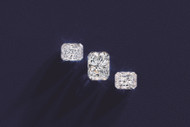Nov 29th 2022
What is a Facet?
Congratulations! You and your partner started browsing for matching engagement rings, and you’re in awe of so many sparkling options. If you look closely, you can practically see the light bouncing off of the little mirrors on each diamond. These mirrors are actually called “facets,” and we’re going to tell you more about them!
What is a Facet?
A facet is a flat, polished surface on a diamond/gemstone, and it can have several shapes, including triangles, octagons, trapezoids and kites. A diamond is made of many facets, and their placement determines the amount of light reflecting through the stone. Therefore, this impacts brilliance and fire. In fact, a round cut center stone — the most popular shape for engagement rings — contains nearly 60 facets!
Anatomy of a Diamond
Before we go any further, it’s important to understand the basic structure of a diamond, as certain facets are located in different sections of the gem. A diamond is basically divided into two parts. The top portion of a diamond is called the “crown,” and the V-shaped, bottom portion is called the “pavilion.” The “girdle” (aka the thin border around the widest part of the diamond) separates the crown and pavilion.
Types of Facets
● Table facet: This is a fairly large facet, and you can likely recognize it by shape. It’s the flat, horizontal facet that sits at the very top of a diamond. This piece influences a gem’s overall sparkle, as it lets the most light into the stone. As light passes through the diamond, it hits other facets and ultimately gets reflected back to your eye.
● Star facets: These facets are also found at the top of a diamond. They encircle the table facet and allow more light to enter the gem. These pieces are positioned at different angles and cause light to start moving in different directions throughout the stone. This creates that eye-catching sparkle!
● Main facets: These can be some of the biggest facets, and they’re scattered throughout the stone. To put it simply, these facets have different roles, depending on where they’re positioned. For example, facets located near the top of a gem bring in additional light. On the other hand, those positioned further down produce more flashes of color (aka sparkle)!
● Break facets: You can find these elongated facets running along the girdle, and they’re known to distribute light farther than some of the other facets. If a diamond has more break facets, that means more light will be directed back to your eye.
* Pro Tip: All of these facets make
up the crown of a diamond, but only main and break facets are found in the
bottom portion of the gem (aka pavilion).
Have a question? We can help!
Gage Diamonds is Chicago's premier jewelry showroom and online retailer of engagement rings, wedding bands, and fine jewelry. We offer a selection of dazzling handpicked diamonds, including certified natural and lab-grown diamonds.
We’re committed to helping you find the ring of your dreams. For inspiration, browse our selection of natural and lab grown diamonds, or set up an appointment with a member of our trusted staff at our in-person showroom.
We offer no-credit-needed financing – feel free to apply and get your approval within 24 hours!
Pay over time, because love shouldn’t wait.
 VISIT OUR SHOWROOM
VISIT OUR SHOWROOM Reviews on Google!
Reviews on Google!





